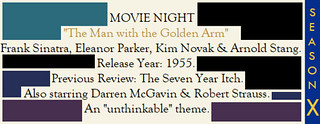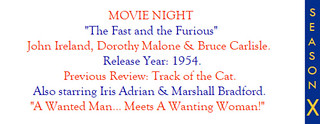 Review #1402: On the Beach.
Review #1402: On the Beach.Cast:
Gregory Peck (Commander Dwight Towers), Ava Gardner (Moira Davidson), Fred Astaire (Julian Osborn), Anthony Perkins (Lieutenant Commander Peter Holmes), Donna Anderson (Mary Holmes), John Tate (Admiral Bridie), Harp McGuire (Lieutenant Sunderstrom), Lola Brooks (Lieutenant Hosgood), Ken Wayne (Lieutenant Benson), and Guy Doleman (Lieutenant Commander Farrel) Produced and Directed by Stanley Kramer (#139 - Guess Who's Coming to Dinner and #228 - Inherit the Wind)
Review:
"I take a very reluctant and conservative view on what a single film can do in affecting our lives. I don't make films to stir the world. I am not conscious of a responsibility to society or even to my own social consciousness when I make a film. My motivation can be as simple as saying, gee, this would make an exciting picture."
Message films, with the right execution, can strike a chord with an audience. Stanley Kramer was a director-producer who liked to specialize in these type of films throughout his career in film. Kramer had written columns for his university paper and graduated with a business degree from New York University, and it was his zest for writing that led to a internship with 20th Century Fox (as opposed to his initial ambition for law), which led to a variety of small jobs around the Hollywood studios for over a decade, such as set furniture mover, writer-researcher, and film cutter. His plan to make his own independent production company was delayed due to Pearl Harbor, and Kramer served underr the Signal Corps to make training films. After the end of the war, he formed a partnership alongside writer Herbie Baker, publicist George Glass and producer Carl Foreman to form Screen Plays Inc. They set out to make films with stories they wanted to do that had something of value to say as per their personal taste without needing to rely on stars. Their attempts at producing independent films met with a few notable films such as Champion (1949), The Men (1950), and High Noon (1952). In 1951, Columbia Pictures signed Kramer and the company to a deal that would give them their own production unit within the studio that gave them free rein and increased budgets. It did not last the contracted five years, and Kramer felt that this one of the most dangerous moves of his career. In a three year partnership, he would produce films such as The Wild One (1953) and The Caine Mutiny (1954) before deciding to enter the foray of directing and producing with Not as a Stranger (1955). This was his fourth work, released between noted films The Defiant Ones (1958) and Inherit the Wind (1960), and it simultaneously premiered on all seven continents one week before Christmas Eve. Despite fair reviews, it was not a big hit with audiences, although it has found appreciation in later years.
Can you imagine what the world would look like after a massive event that affected people's lives and led to long-term consequences? Authors have written apocalyptic and post apocalyptic fiction for as long as people have been around on this Earth, with the modern age being no different in inspiring further looks into what a world would look like with disaster from nuclear fallout, or from something like disease or the environment. Nevil Shute wrote one such work on the apocalypse, writing his work in 1957 while residing in Australia (he also worked as an aeronautical engineer and pilot before his death in 1960). The novel has been turned into a film twice, with the other adaptation being a TV film in 2000. Shute found dissatisfaction with this adaptation when it came to certain aspects of the novel, particularly the romance between Peck and Gardner's characters being more pronounced than in the book when it came to the former's fidelity to his dead wife (Peck agreed with this privately). It certainly must have been an interesting film to view for the time (where this decade had seen war in Korea and continuing Cold War tension) - a bleak movie through and through, where blame is not given to any one side of the unseen war. While one is spared visual decay of vanquished people or even the effects of radiation on the survivors, the film manages to do well enough in maintaining itself in grim composure that makes one think about their future that could have been or the future that could be for what was the future of 1964, complete with filming in Australia. Peck handles himself with resolve in a mellow voice that can handle impending doom and conflicting feelings with care. Two actors playing against the type they were usually known for in film are femme fatale Gardner and song-and-dance Astaire, and each follow Peck fine, making light romance and guilt come out with some effectiveness. Perkins and Anderson give off a bit of intimacy and anxiety decently enough, although they don't stick out as much as they could when it comes to such a dreary quiet time. It is the sights and what one can see and doesn't see within the Australia landscape and beyond (such as a shot of the Golden Gate Bridge with no one present) that drives the film for 134 minutes with adequacy. It comes off with an urgency that warns for the future without becoming too much of a lecture to stand on its own as a film of oblivion that resonates still after over six decades since release.
Overall, I give it 7 out of 10 stars.
And now, an announcement for the month of May, comprised of 30 films.


 Review #1401: Pillow Talk.
Review #1401: Pillow Talk. Review #1400: The 400 Blows.
Review #1400: The 400 Blows. Review #1399: Rio Bravo.
Review #1399: Rio Bravo. Review #1398: Cairo Station.
Review #1398: Cairo Station. Review #1397: Gigi.
Review #1397: Gigi. Review #1396: Nine Lives.
Review #1396: Nine Lives. Review #1395: Gunfight at the O.K. Corral.
Review #1395: Gunfight at the O.K. Corral. Review #1394: An Affair to Remember.
Review #1394: An Affair to Remember. Review #1393: Around the World in 80 Days.
Review #1393: Around the World in 80 Days. Review #1392: The Searchers.
Review #1392: The Searchers. Review #1391: The Man with the Golden Arm.
Review #1391: The Man with the Golden Arm. Review #1390: The Seven Year Itch.
Review #1390: The Seven Year Itch. Review #1389: Kiss Me Deadly.
Review #1389: Kiss Me Deadly. Review #1388: The Fast and the Furious.
Review #1388: The Fast and the Furious.